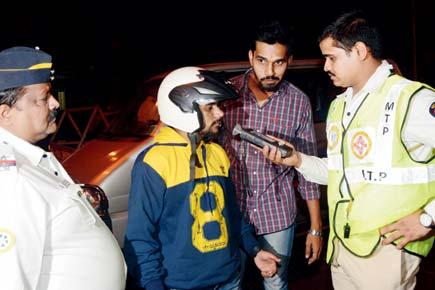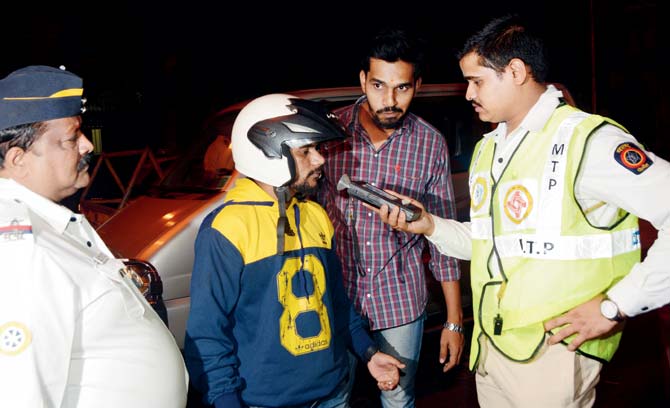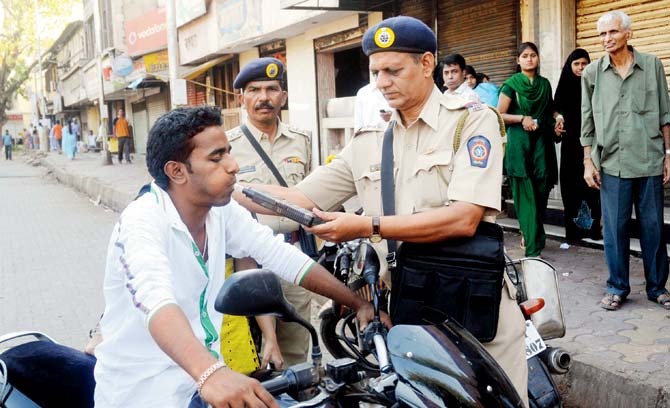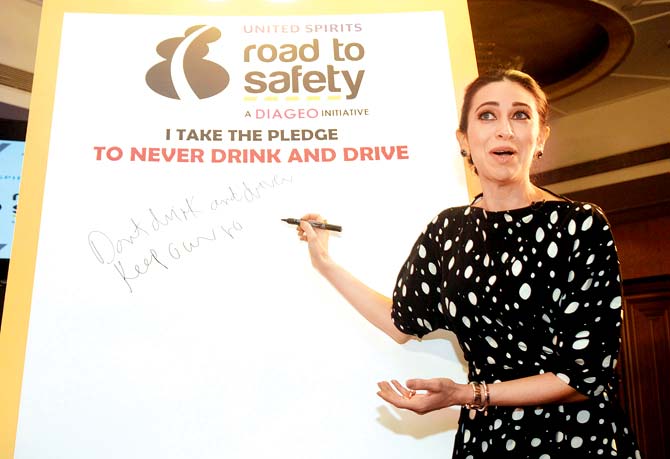Alarming data collected by a US organisation reveals Mumbai Police's relentless campaign against drink-driving has yielded no results; fatalities up by 114% in five years


Traffic police personnel now have over 150 automated breathalysers that can keep a record of past offences
ADVERTISEMENT
In the war against drink driving, the Mumbai Police has done it all - carried out awareness drives, won the Internet with cheeky tweets, roped in celebrities to influence motorists, launched an on-the-spot e-challan system, increased the number of checkposts, deputed over 1,000 personnel on the roads and handed out more breathlysers to them. But, none of it has worked. Rather, the number of fatalities caused by drink driving has increased by 114% in the last five years.

Traffic police personnel have now been given automated breathalysers that can keep track of past offences. Pic for representation
In 2016, 14 accidents caused by drunk drivers caused 15 deaths in Mumbai. In comparison, the figures were smaller in 2011 - six accidents claimed seven lives then.
The alarming data (see table) was collated by US-based Bloomberg Philanthropies as part of its global road safety initiative (see accompanying story). The findings of the study underscore the failings of the police's relentless campaigns against drink driving.

Celebs like Karisma Kapoor have thrown their weight behind the anti-drink driving campaign
Amitesh Kumar, joint commissioner of police (traffic), confirms that the numbers of accidents as well as fatalities have increased, and are a cause for concern. "For the last three years, the traffic police department has been focusing more on preventing rule violations. Rash driving and drink driving need to be prioritised more," he admits.
Campaign fell short
After linking most fatal accidents with drunk motorists, the city police launched its 'don't drink and drive' campaign in 2007. From nakabandis to billboards, ad spots on TV and radio, and even gifting roses to motorists, the campaign pulled out all the stops to inspire responsible driving.
"We have taken many initiatives to curb the menace over the years," asserts Kumar.
In January last year, the Bombay HC ordered that both the central and the state governments adopt a zero tolerance policy towards drink driving, stressing that the mere presence of alcohol in a driver's blood should be sufficient to disentitle him from driving, with immediate suspension of licence.
Keeping up with the times, the traffic police department even switched to automated breathalysers, which send photographs and a measure of the alcohol content to the main server, and issue receipts on the spot. Today, the department has over 150 such devices in its kitty.
Besides, the police carry out a nakabandi every weekend, beginning Friday night, in 34 city divisions. 'Black spots' (which have a high concentration of accidents) and routes close to bars and restaurants are watched keenly.
Kumar admits that these measures are still not enough. "That's why we are also setting up alcohol meters at many bars and restaurants to let people know how much alcohol they have consumed and whether it's within the permissible limit."
The permissible blood alcohol content is set at 0.03% per 100 ml of blood. That works out to 30 mg of alcohol per 100 ml of blood. Although figures vary for everyone, an average person weighing about 65 kg can stay within the legal limit if s/he consumes two pints of beer (equivalent to 660 ml), or one large whiskey peg (60 ml), or two glasses of wine (200 ml). The body takes about an hour to process 29.5 ml of alcohol. Since each type of liquor has a different alcohol content, to be able to drive again without one's reason and coordination being affected by it, one must wait for at least 90 minutes after a pint of beer and three hours after a large whisky or two glasses of wine.
But even with the new plans in place, the police are keenly aware of their shortcomings. "We can't put a police personnel at every junction at night. When we studied the accidents, we found that pedestrians were the biggest casualties of drink driving," says a police officer. "In 2016, there were 529 accidents which caused the death of 562 persons. Of these, 52 per cent were pedestrians."
Driving with impunity
Despite knowing the perils of driving drunk, what makes a motorist willing to take the risks? Hvovi Bhagwagar, a clinical psychologist and trauma therapist, blames the won't-happen-to-me syndrome. "It's largely those in the age group of 28-38 who are behind most drink driving accidents."
Dr Kersi Chavda, consultant psychiatrist at Hinduja and Hurkisondas hospitals, adds, "There are two types of people - the youth who believe nothing wrong can happen to them and those in the older age group who are deluded enough to believe that they can take the wheel. This latter attitude percolates to the younger lot over time."
 Subscribe today by clicking the link and stay updated with the latest news!" Click here!
Subscribe today by clicking the link and stay updated with the latest news!" Click here!






